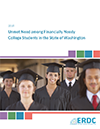This report concerns Washington high school graduates who entered Washington public higher education institutions and at some time received need-based financial aid. It looks at the persistence and completion rates of these students over six years. It is part of a larger series of studies that explore the impacts of need-based financial aid on completion of postsecondary education.
There are more women than men in the study
There are many more women in the study cohorts than men. This is the result of several factors:
- The high school graduating classes of 2008 and 2009, the starting point for this study, include more women than men.
- Women are more likely than men to pursue postsecondary education.
- Women are more likely than men to receive need-based financial aid.
Furthermore, women are more likely than men to earn a degree. For these reasons, the findings of the study were disaggregated by gender.
Students with greater amounts of unmet need were less likely to persist and complete than students with lower amounts of unmet need
Not surprisingly, students having higher levels of “unmet need” (basically, the costs of higher education — tuition, room and board, books, etc. — not covered by family contributions and financial aid) are less likely to continue attending college and graduating.
In spite of being less expensive, community and technical colleges have higher levels of unmet need than the public four-year institutions
Somewhat surprisingly, the levels of student unmet need are higher at the community and technical colleges (CTCs) than at the four-year universities and college. Even though the costs of attending community or technical colleges are considerably less than at four-year institutions:
- The students attending community or technical colleges generally are poorer and the expected family contributions are less.
- The financial aid packages at community and technical colleges are smaller than at four-year institutions.
Students with better high school academic records are more likely to receive better financial aid packages
Among all the cohorts, students with higher high school GPAs, on average, had lower amounts of unmet need (as measured by either the first-year level of unmet need or the average annual amount of unmet need). With the exception of men who started at a four-year institution, students who had met the high school math assessment standard were more likely to have lower amounts of unmet need.
Students attending the four-year institutions borrow more than students attending the community and technical colleges; students attending the community and technical colleges work more than students attending the four-year institutions
One-half of the students beginning at a four-year institution borrow an average $6,000 in unsubsidized loans in their first year while only about 10 percent of the beginning CTC students borrow, on average, $2,600. Two-thirds of the first-year CTC work about 15 hours per week during the academic year, earning $6,000, while one-half of the first-year four-year students work six hours per week, earning $2,200.
Even students who do not complete a bachelor’s degree borrow
Not all students graduate, and many students who do not graduate take out loans. Overall, 70 percent of the students who start at a four-year institution earn a bachelor’s degree within six years after graduating from high school. Of the remaining students who do not earn a bachelor’s degree, 85 percent leave with an average $19,000 in debt. At the CTCs, of those who do not earn a bachelor’s or associate degree or a long-term certificate, 35 percent incur an average $9,000 in debt.


